
Aspiring Educators Chapter Toolkit
How to use this toolkit
This toolkit and all of its resources have been created by college student leaders just like you to help you create, build, and expand your NEA Aspiring Educators chapter. You can find things like a sample constitution, social media strategies, and financial information. Some things are even immediately transferable to your own needs, like the sample meeting agenda or the leadership planning guide.
Introduction
Welcome!
If you have found your way to this toolkit, chances are you are a college student passionate about entering your career as an educator. You want to meet and network with others on your campus and beyond who share your enthusiasm. You want to get more involved in your local community, strive for social justice, and leave a legacy for your students, your community, and the profession.
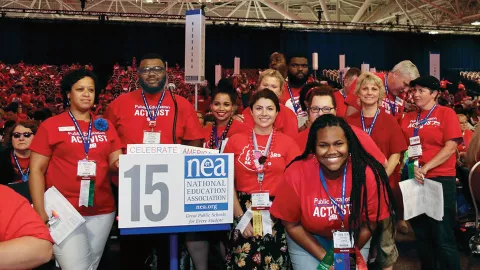
This toolkit and all of its resources have been created by college student leaders just like you to help you create, build, and expand your NEA Aspiring Educators chapter. You can find things like a sample constitution, social media strategies, and financial information. Some things are even immediately transferable to your own needs, like the sample meeting agenda or the leadership planning guide. This toolkit is meant to grow and expand with our program, so if there’s something you think isn’t included but should be, please reach out via the email below to let us know.
Another of our favorite sections is the history of the Aspiring Educators Program and how it came to be in the National Education Association. Our program has a rich history of mergers, name changes, and culture shifts to appropriately reflect the passion, commitment, and vision of our current members. As you continue to read the first chapter, you’ll see more information on how the Aspiring Educators Program fits into the larger organization.
As you start your journey as an Aspiring Educators chapter leader, there are hundreds of aspiring and experienced educators all around you in your community just waiting to help you, and we’re always an email away, too. Our hope is that your NEA state affiliate can provide support through a state staff member assigned to check in on you, provide funding for local events and travel to state and national conferences, additional professional learning resources, and so on. We assure you that this union can provide you with the tools you need to succeed in the profession—you just have to take advantage of it.
Welcome to your biggest support system: the network that, if you allow it, will push you outside of your comfort zone to ensure you are as strong and prepared as you can be as you enter the education profession. By joining the National Education Association, you are connecting with 3 million like-minded leaders and advocates from across the country. Welcome to our NEA family. Welcome home.
In solidarity,
NEA Aspiring Educators
[email protected]
Why Start an NEA Aspiring Educators Chapter?
Why Start an NEA Aspiring Educators Chapter?
The NEA Aspiring Educators Program is the leading voice for the next generation of educators. Over 50,000 members in 1,100 campus chapters across the nation belong to the program, which began as the Student-National Education Association in 1937 and eventually became part of the National Education Association as the NEA Student Program. The current new name reflects the passion, commitment, and vision of members who believe in public education and its potential to uplift individuals, families, and communities.

Through our core values, we promote educator quality, community engagement, political action, and social justice. Aspiring Educators become activists at all levels of the organization -- local, state, and national. The NEA Aspiring Educators Program provides opportunities to engage with community partnerships and foster leadership development.
Most of all, we support, develop, and empower diverse aspiring educators to create high-quality education leaders and advocates in every school so that all students can maximize their potential.
College students preparing to be educators often face unprecedented challenges. In times of high stress, creating a local union family for aspiring educators to lean on builds educator resilience. Before they have even entered the profession, we have increased the odds they will stay in education long term. If these supports existed for every aspiring educator, we could greatly increase educator retention in the field.
Chapters also provide members the opportunity to build educators’ skills, knowledge, and dispositions prior to entering the classroom. Professional learning opportunities, building an educator network, engaging with grassroots community coalitions, understanding a racial justice lens in education, and advocating for students inside and outside of the classroom are all components that chapters support in their activities and goals.
For more specific details, reach out to your NEA state affiliate for information on its Aspiring Educators Program.
NEA Aspiring Educators History
NEA Aspiring Educators History
Future Teachers of America Established
Future Teachers of America (FTA) was created in 1937. This idea was originated by Joy Elmer Morgan, the editor of the NEA Journal for more than 30 years. FTA began as an organization of both high school and college students geared to support young people interested in becoming teachers.
Student-NEA Established
In the mid-1950s, NEA’s National Commission on Teacher Education and Professional Standards recommended separating the high school and college components of FTA and developed plans to establish a new collegiate student membership organization—the Student-National Education Association (Student-NEA). The intention was to replace the FTA college program while enduring the high school program with FTA. The 1957 NEA Representative Assembly (NEA RA) approved this new structure, and Student-NEA was officially established.
Its goal was to deepen the interest of capable students in teaching as a career, encourage the careful selection and guidance of persons admitted to teacher-education programs, and, through higher standards of preparation and the dissemination of information, contribute to a balance in teacher supply and demand.
Student-NEA and the Civil Rights Movement
By June of 1959, Student-NEA university chapters reached 745 with a membership of 51,782. The culture of university student-led protests, demonstrations, and movements like the Student Free Speech Movement and Civil Rights Movements, led to university students questioning their authority in the nation an higher education.
From 1966 – 1970, Student-NEA remained relevant during this time of student activism because it focused programs on desegregation, political action, and teaching competency. Teacher education and school integration focused on bringing together Black and White student teachers and teacher education leaders in region that was drastically changing due to civil rights legislation. A series of conferences were held throughout the South, which exposed many members to mixed-race groups and opened conversations about the meaning of equalizing education opportunities for students.
Project 18 was a coalition of student and civil rights groups to create national legislation allowing 18 year olds to vote. Led initially by Les Francis and concluded by Roslyn Hester, the two NEA staffers led the coalition in a successful legislative initiative. The coalition included the National Student Association, NAACP, and CORE. President Nixon signed the legislation into law.
From 1966–1970, student membership ranged from 150,000 to 300,000 and existed as one of the largest dues paying membership organizations in the country. Student-NEA staff consisted of: director, assistant director, two professional staff, one student editor, and one assistant editor. Mel Myler served as president of Student-NEA from 1966–1967 without release. He was hired as staff to bring “student perspective” in 1967 and served the organization until 1970. The program was housed in the Teacher Education and Professional Standards department of NEA.
Student-NEA and the NEA
The 1976 NEA Representative Assembly amended the NEA Bylaws to establish Student-NEA as a special category of NEA affiliate comprised solely of student members of the Association and set forth specific affiliation standards for this new organization. The Bylaws provided that Student- NEA would be a “self-governing organization.” In this structure, it could set dues and it could not duplicate Association services. Further, it had to comply with NEA’s broader standards of affiliation including: unified membership, open nominations and secret ballot elections, the one-person-one-vote principle on its governing bodies except
that it did need to guarantee ethnic-minority representation, the same membership year as NEA, and a guarantee of due process for its members.
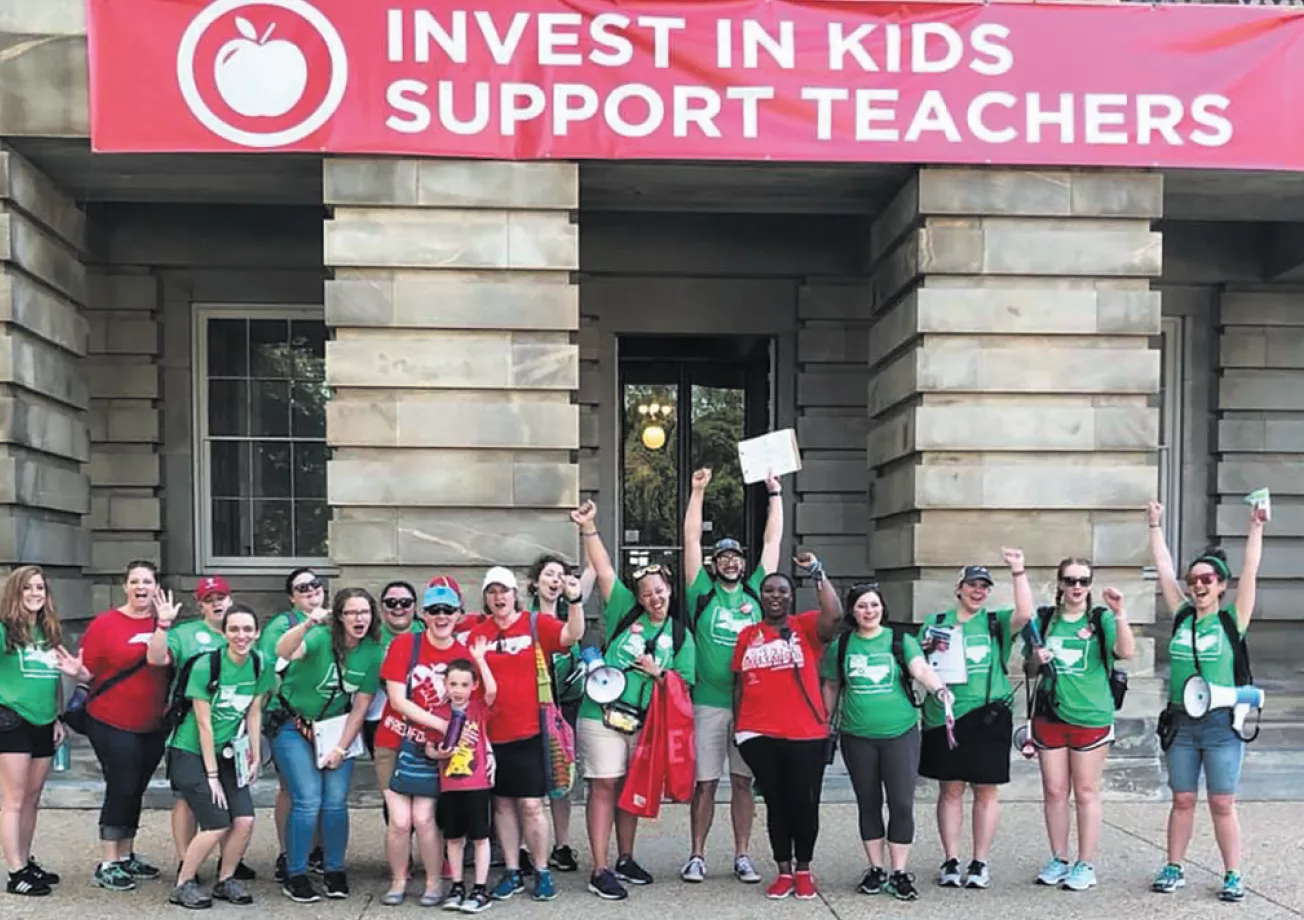
Student-NEA and NEA subsequently entered into a contract arrangement designed to establish organizational autonomy for Student-NEA within NEA, including independent staff, programs, and budget. Over time, this autonomy resulted in a range of undesirable factors that negatively impacted student programs, member involvement, and overall financing. Concerned about these negative consequences, a “Committee to Study the Long-Term Relationship Between the Student-NEA and the NEA” was formed. The Committee’s recommendation was a reunification of student members within NEA.
Student-NEA Board of Directors and NEA Board of Directors met in June and September 1982, and concurred with the Committee’s recommendation. Central to the plan approved by both the Boards were the following concepts:
- Reunification of Student members within the NEA organizational structure
- Continued commitment to the Student category of NEA membership and governance rights for Student members
- Creation of an advisory committee of Student members
- Establishment of a special NEA office to supervise and implement Student programs
- Provision of service to Student members through the state affiliates
In 1982-1983, the NEA Board of Directors authorized the development of the amendments package to accommodate the new structure. The Student-NEA RA concurred with the package in March 1983. Following this, Constitutional and Bylaw amendments were submitted for vote by the 1983 and 1984 NEA RAs.
The Bylaws of the 1983 RA:
- Eliminated the Student-NEA as a special affiliate of NEA and deleted the standards for Student-NEA
- Provided that dues of Student members be established by the NEA RA in the program budget recommended by the NEA Board
- Changed the basis for allocation of Student delegates to the NEA RA
- Established new conditions for the election of Student members to the NEA Board
- Assigned certain responsibilities to an advisory committee of Student members
The Constitutional amendments submitted at the 1983 RA and approved at the 1984 RA:
- Deleted from the Constitution references to the Student-NEA
- Substituted as appropriate the words “student” or “Student Members” of the Association
- Changed student representation on NEA Board from Student-NEA affiliate entitlement to an entitlement of the Student members of NEA
- Eliminated references for allocation of student delegate credentials and set forth the provisions in the Bylaws
NEA Student Program
In conjunction with NEA’s official changes, Student-NEA was dissolved by a vote of its members. The NEA Student Program began operations in the 1983-84 membership year.
- 1972 – First full-time officer
- 1975 – Deliberations
- 1976 – Incorporated
- 1983 – Terminated separate affiliation and remerged with NEA as a program
Beginning in 1983, each year student representatives were appointed to selected NEA Standin Committees, three elected student representatives served on the NEA Resolutions Committee, and three members were elected to the NEA Board of Directors.
“The purpose of the Association shall be to develop in prospective educators an understanding of the education profession, to provide for a united student voice in matter affecting their profession, to influence the conditions under which prospective educators are prepared, to advance the interests and welfare of students preparing for a career in education, to promote and protect human and civil rights, and to stimulate the highest ideals of professional ethics, standards, and attitudes.”
Bylaws were adopted by members of the annual Representative Assembly, incorporated as Article I, Section 2.
“Outreach to Teach,” a community service project that included student, active, and retired members who renovated local community public schools, was established.
In the mid-2000s, three core values were established that described the NEA Student Program.
As a result of membership decline in the 2011-2013 budget cycle, which followed the Great Recession of 2008’s financial crisis, NEA focused attention on reducing costs and budget. During the 2014 RA, funding for the Outreach to Teach project was drastically reduced. This caused the need for a re-design of the Student Leadership Conference community outreach project.
The Leaders Empowering Grassroots Advocacy for Communities and Youth (LEGACY) Project continued the tradition that students and retired members had previously in its community outreach event. The intent of the project was to reach a larger community by bringing together community leaders, organizations, and unions to demonstrate to the students in the area that their community is committed to their success. The intention is for hundreds of children taking part in educational activities and events where they are able to learn about their unique community while providing opportunities for aspiring educators to learn about community organizing and activism from NEA-Retired and community members. The project location is dependent on the location of the Student Leadership Conference and Representative Assembly and adapts to the needs of each community where it is hosted.
NEA Aspiring Educators
The language began to shift from Student membership to Aspiring Educators in 2014 because of their preference to be viewed as professionals who will soon enter classrooms and to reflect the diversity of our membership, both young professionals and non-traditional college students. By a vote of the 2018 NEA Representative Assembly, the name was officially changed from the NEA Student Program to the NEA Aspiring Educators Program.
Communities Redefining Education Advocacy Through Empowerment (CREATE) Grants are grants university chapters may apply for to create chapter events within their community around Teacher Quality, Community Outreach, and Political Action. In 2016, the Advisory Committee on Student Members changed the word Communities to Chapters. This committee also changed Teacher Quality to Educator Quality to more appropriately reflect the wide range of careers we seek to join, Community Outreach to Community Engagement to promote a more meaningful, authentic, and mutually beneficial partnerships with our chapters and their local communities, and added Social Justice as our fourth core value to reflect the need to incorporate justice, equity, and the fight for liberation in public education.
In 2015, the Aspiring Educators Caucus was created as a tool to utilize NEA’s governance structure and allow for student members to take official positions on issues they care about, endorse NEA candidates running for office, and to organize around value propositions of the NEA. The Aspiring Educators Caucus established their first set of Constitution, Bylaws, and Standing Rules along with their first leadership council in 2019.
NEA Aspiring Educators Core Values
NEA Aspiring Educators Core Values
The NEA Aspiring Educators Core Values—Educator Quality, Community Engagement, Political Action, and Social Justice—direct Aspiring Educators activities. It is in these areas that our members and affiliates sponsor programs, educate on issues and effect change.
NEA Aspiring Educators Core Values
Educator Quality encompasses how Aspiring Educators practice professional learning and gain insight on career preparation at local meetings and workshops, state conferences, and national symposiums. NEA shares resources on information relevant to members, including certification requirements and resources for working with diverse learners. Aspiring Educator members and chapters partner with local associations to enhance in-the-classroom opportunities and secure real-world insights into the education profession. Aspiring Educators shape their college curriculum by serving as change-agents on boards and committees. Involvement in the NEA Aspiring Educator Program enhances and strengthens the professional expertise of pre-service educators prior to entering the profession.
Community Engagement describes how NEA Aspiring Educators members engage the people and environment around them. Members of the NEA Aspiring Educators Program seek to have impact — locally and globally — and value the mutual relationship which prepares them to support their future students through the communities that support them. Members learn about communicating with families, partnering with local businesses, and establishing mutual support through Chamber of Commerce consortiums. They design and implement projects such as after-school tutoring programs, learning carnivals, and senior citizen dances. Getting involved in local communities means supporting students where they live, through the people and businesses they interact with daily, and preparing Aspiring Educators to not only be outstanding professionals, but community leaders.
Political Action includes the knowledge, advocacy, and action around political and legislative issues in public education. NEA Aspiring Educators elevate issue awareness around vouchers and charter schools, state-mandated certification issues, and new educator rights and supports. Members share information with peers, families, and communities around how legislative decision making affects pre-service educators, communities, students, and schools. NEA Aspiring Educators chapters sponsor voter registrations, get-out-the-vote activities, contact elected officials, help elect pro-public education officials, and lobby at the local, state, and national levels in government. By educating their colleagues, organizing activities and publicizing their involvement, Aspiring Educators create a lasting impact on education politics.

Social Justice refers to a sustained and intentional focus on building a more just and equal society by bringing inequality, discrimination, and oppression to light and helping traditionally marginalized groups gain access to opportunity. NEA Aspiring Educators are committed to tackling the immense occurrence of social injustice and institutional racism in their communities to create awareness and promote activism to eradicate the problem. Aspiring Educators chapters demonstrate their collective knowledge and awareness, advocacy, and action around one of NEA’s top priority issues, social and racial justice.
NEA Mission Vision Values
Adopted at the 2006 NEA Representative Assembly
The National Education Association
We, the members of the National Education Association of the United States, are the voice of education professionals. Our work is fundamental to the nation, and we accept the profound trust placed in us.
Our Vision
Our vision is a great public school for every student.
Our Mission
Our mission is to advocate for education professionals and to unite our members and the nation to fulfill the promise of public education to prepare every student to succeed in a diverse and interdependent world.
Our Core Values
These principles guide our work and define our mission:
- Equal Opportunity. We believe public education is the gateway to opportunity. All students have the human and civil right to a quality public education that develops their potential, independence, and character.
- A Just Society. We believe public education is vital to building respect for the worth, dignity, and equality of every individual in our diverse society.
- Democracy. We believe public education is the cornerstone of our republic. Public education provides individuals with the skills to be involved, informed, and engaged in our representative democracy.
- Professionalism. We believe that the expertise and judgment of education professionals are critical to student success. We maintain the highest professional standards, and we expect the status compensation, and respect due all professionals.
- Partnership. We believe partnerships with parents, families, communities, and other stakeholders are essential to quality public education and student success.
- Collective Action. We believe individuals are strengthened when they work together for the common good. As education professionals, we improve both our professional status and the quality of public education when we unite and advocate collectively.
NEA Structure
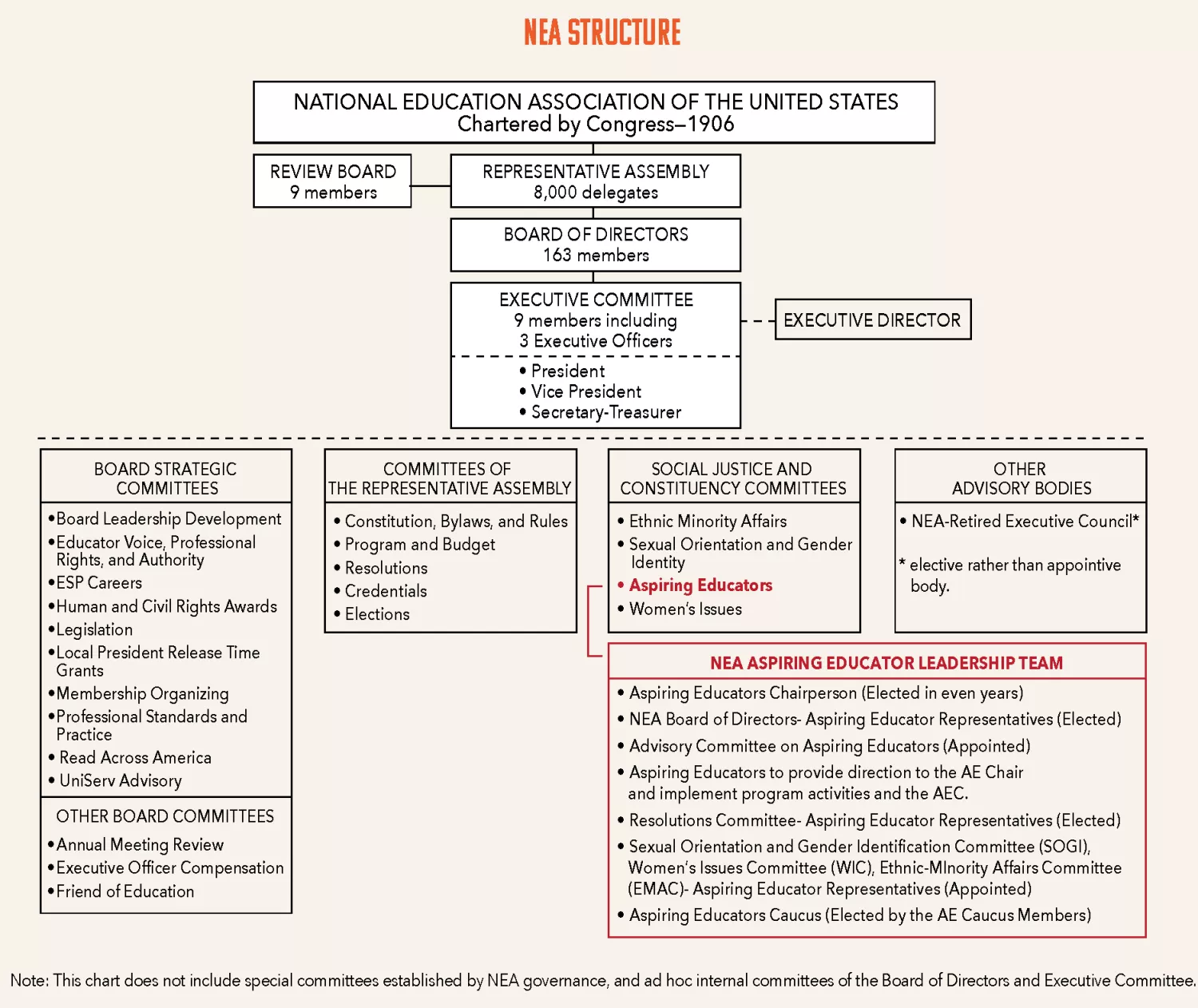
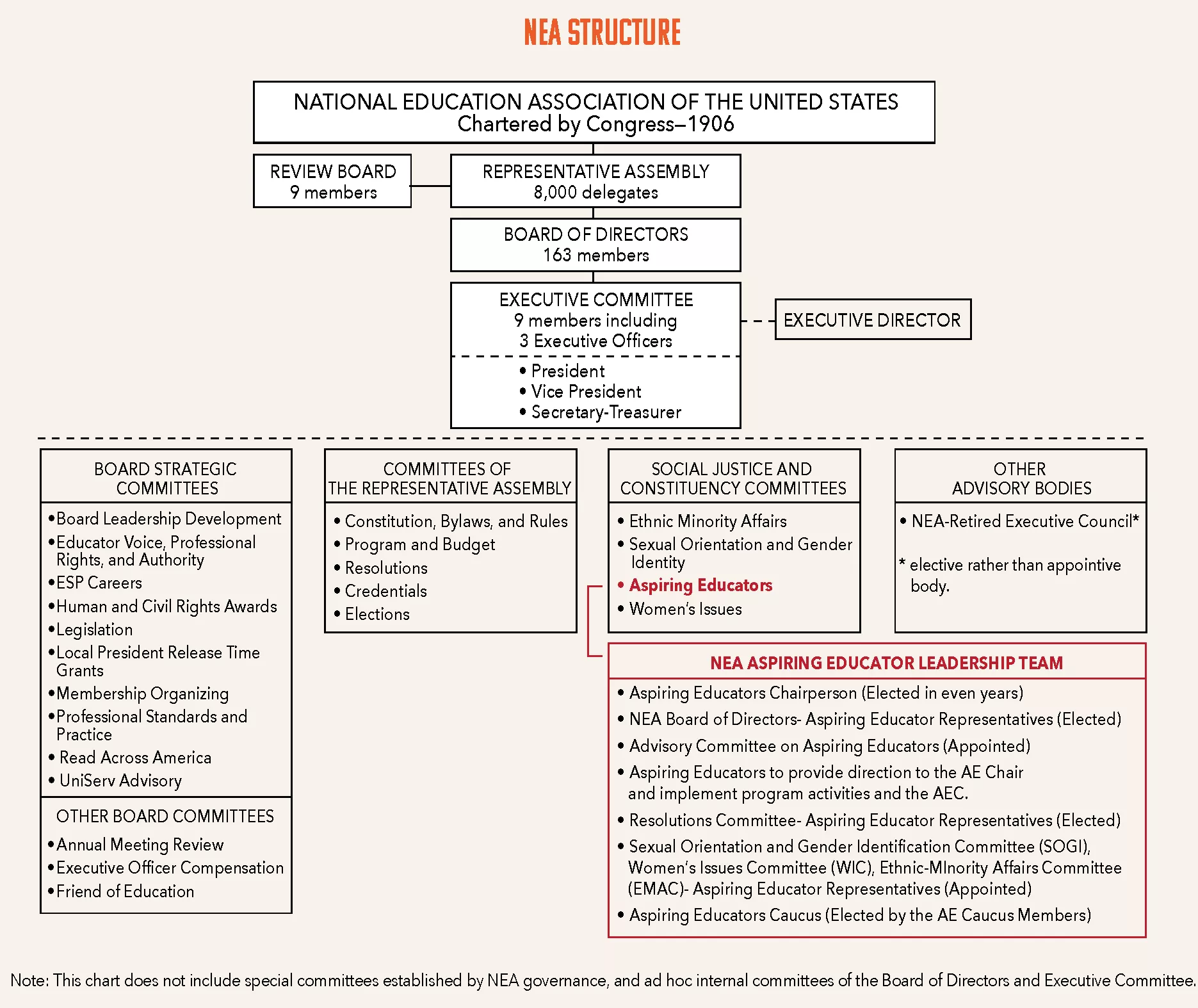
Who Should Use this Toolkit
Who Should Use this Toolkit
No matter your role in education, you can play a part to support aspiring educators in your community. Below are some actions students and affiliates can take to support the Aspiring Educators Program.
High School Student/Future Aspiring Educator
- Even though you’ll have to wait until you’re officially enrolled in college courses to join NEA Aspiring Educators, that doesn’t mean you can’t get involved or start preparing now!
- Reach out to your state Aspiring Educators Program to see what opportunities are open to you right now.
- Start building a team of leaders in your local community that will eventually help lead the organization with you.
- Follow NEA Aspiring Educators on social media to stay updated on potential events and opportunities to get engaged with.
Aspiring Educator
- This is your organization—get a team together, recruit a chapter advisor, and begin organizing!
- Remember, the organization cannot be successful if it is just you. Be sure to prepare a team of successors to continue growing the chapter after you graduate.
Faculty/Staff Member
- Most colleges require student organizations to have a faculty or staff member to sponsor and advise their club or group. Their level of participation is determined by the college, but it is also influenced by how your chapter chooses to operate. Having official support is critical to establishing a chapter, however.
Local NEA Educator/Leader
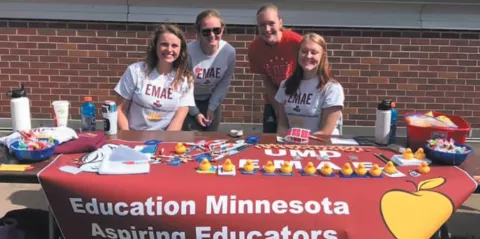
- Your support in developing Aspiring Educators in your local community can help to expand a chapter beyond their physical campus.
- Make sure the chapter has a team of leaders and a faculty or staff advisor to be established as a registered student organization on campus.
- Invite Aspiring Educators to your meetings and events, and let them know you’re interested in attending their activities as well.
- Offer your expertise in the form of a professional development opportunity or professional mentor.
- Advocate in your local or state NEA affiliate for more funding and leadership opportunities for Aspiring Educators members.
NEA State/Local Affiliate
- Assign a state Aspiring Educators organizer.
- Partner local affiliates with local campus chapters.
- Provide funding and additional resources to chapters.
- Encourage Aspiring Educators to attend your events and meetings. Ensure that their participation and active contribution is included and not just as an observational role.
Establishing a Chapter
Establishing a Chapter
Chartering a Chapter
1. Form a leadership team:
- To guide the formation of the chapter, gather a diverse team of students with the same passion for the education to effectively establish a chapter.
- The students gathered for this team have potential to become the governing officers of the chapter (President, Vice President, Treasurer, etc).
- This team should become aware of the school’s requirements to obtain a club/ organization charter.
- Required number of student members, constitution requirements, meeting location criteria, etc.
2. Contact state NEA affiliate
- Every state has its own NEA affiliate and Aspiring Educators Program. To be NEA union members with your school’s name, contact the state Aspiring Educators Program for steps on affiliation. (NOTE: You may also contact NEA directly for assistance in connecting with the appropriate person in the state affiliate.)
- By forming (or joining) an NEA chapter on a campus, all chapter members can collaborate with other Aspiring Educators across the state and around the country.
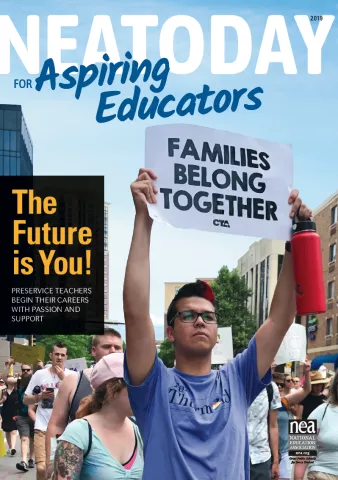
3. Find a faculty or staff advisor
A common requirement among most schools is the need for a full-time staff advisor. For chartering this specific kind of organization, it would be best to enlist the support of an education professor. However, as a student-led group, any supportive full-time staff member works.
4. Draft a constitution
- An important aspect of every chapter is the constitution, which sets the rules and guidelines that govern the organization.
- Bylaws guide the chapter during decision-making processes, and provide information on role charges, official affiliation, goal of the chapter, and election/removal/vacancy proceedings.
- Here’s a sample constitution for you to check out.
5. Contact institution’s student organizations office
Most schools have a department dedicated to student clubs and organizations. This office would provide the information and processes necessary to obtain an official charter from the school.
6. Membership & activities
- Recruiting membership into the chapter is important not only for the chartering portion, but viability of the chapter as a whole. Be sure to recruit membership that reflects the diversity of your community and the nation.
- Recruitment can be done through casual conversation, tabling during club days, or flyers around the school.
- The leadership team should collaborate with the membership on what activities to pursue for the semester.
- When chartering an organization, some schools may ask for preconceived ideas for activities prior to allowing a charter.
- These activities can surround educational issues, social justice issues, or could feature collaboration with other student organizations on campus. The overall goal of these activities are set to properly integrate the Aspiring Educators chapter and its role in student’s lives.
- For more advice on growing your chapter, check out suggestions for member engagement throughout this toolkit.
Three Tips for a Successful Chapter
Three Tips for a Successful Chapter
When leading an organization that has a mission to motivate and prepare the future professionals of the National Education Association, it is crucial for chapter leadership to intentionally recruit a diversity of backgrounds, perspectives, cultures, and voices. Leaders should also seek to value each members’ individual skills and talents, and utilize them to help build and strengthen the chapter. An emphasis on the diversity of members in your chapter will help you to relate to a wide range of audiences on campus, deepen your understanding of perspectives different from your own, and ultimately enrich the education profession.
Planning member activities may feel daunting at times. As mentioned, these events can vary among many different topics. Some chapter events can be as simple as a study group. Team-building in different environments helps create the chemistry needed to show unity in support of public education, racial and social justice, labor unions, etc. Don’t feel compelled to make your chapter look like anything else you’ve seen on campus or across the country. Your chapter should be a reflection of the members and students you seek to serve.
When stepping off your chapter leadership position, it is important to make yourself available to the new leadership to address any questions/concerns. These newly elected/ appointed officers must feel supported in their positions of leadership, which may be overwhelming. In order to guide the chapter, even after graduating/transferring, mentorship and fellowship with these leaders further reinforces the social connection needed between NEA members in the advocacy for the collective advancement of public education.
Sample Chapter Organization, Constitution, and Bylaws
Sample Chapter Organization, Constitution, and Bylaws
Constitution
CONSTITUTION OF THE _______________________________________________________________*
OF THE (STATE ASPIRING EDUCATOR PROGRAM NAME)
ARTICLE I. Name and Location
Section 1. The name of this association shall be _________________________________________**
_______________________________ hereinafter known as the Association.
Section 2. Headquarters for the Association will be maintained in
_____________________________
______________________ *, _____________________________________County, (State).
ARTICLE II. Purposes
Section 1. Promote interest among young adults who are interested in education careers.
Section 2. Provide members with opportunities for developing personal growth and professional competence.
Section 3. Provide opportunities for gaining an understanding of the history, ethics, and programs of the education profession.
Section 4. Provide opportunities for participating in cooperative work on the problems of the profession and the community.
Section 5. Provide professional membership on the local, state, and national levels during the preparation period for a career in education.
Section 6. Strive for higher standards of preparation.
ARTICLE III. Membership
Section 1. Membership in the Association shall be open to any _____________________________
______________________________ (name of your school) student preparing for a career or interested in education who has never been eligible for any other category of membership within the NEA.
Section 2. In addition to being a member of the Association each member shall be affiliated with the State and National Student Aspiring Educators Program. A person shall not be admitted to or continue membership in the Association who possesses a teaching contract or who receives payment for teaching duties rendered — with the exception of graduate students receiving graduate teaching assistantships.
Section 3. The membership year shall be from September 1 to August 31.
Section 4. Membership will not be denied on the basis of race, gender, sexual orientation, or physical challenge.
ARTICLE IV. Officers
Section 1. The officers of the Association shall be responsible to the membership in all matters concerning the discharge of their duties.
Section 2. The officers of the Association shall be a President, a Vice President, or President-Elect, a Secretary, a Treasurer (Secretary/Treasurer could be one individual), an Editor, and a Historian (Editor/Historian could be one individual). (A local may have additional officers, but it must have those listed in this section.)
ARTICLE V. Organization
Section 1. EXECUTIVE COMMITTEE: There shall be an Executive Committee composed of the officers, state officers from the local, and the local advisor(s).
Section 2. GENERAL MEETING: There shall be ________ general meetings of the members of this Association annually.
ARTICLE VI. Affiliation
Section 1. The Association shall be affiliated with the (State and National) NEA Student Aspiring Educators Programs.
Section 2. The Association shall not affiliate with any local, state, or national group, union, or association that competes for membership with the (State and National) Association.
ARTICLE VII. Amendment Process
Section 1. This Constitution may be amended at any regular meeting by a two-thirds (2/3) vote of the members present and voting.
Section 2. Proposed amendments must be submitted in writing to the Secretary and read at the previous regular meeting.
Section 3. EFFECTIVE DATE: Any amendment(s) to this Constitution shall become effective immediately upon approval by the membership.
ARTICLE VIII. Suspension of Rules
Section 1. Any section of any article of this Constitution may be suspended by a two-thirds (2/3) vote at any general meeting, provided that any request for a suspension must be accompanied by a statement of the purpose for the suspension of the rules.
Section 3: EFFECTIVE DATE: Any amendment(s) to this Constitution shall become effective immediately upon approval by the membership.
Download a printable version of the sample constitution
Bylaws
ARTICLE I. Officers
Section 1. The term of office for the officers shall be one year or until their successors are duly qualified. Incumbents are eligible to seek reelection for one additional term. The officers shall assume office on _______________________________________________ following their election.
Section 2. President:
a. shall be the chief executive officer of the Association;
b. shall represent the Association as spokesperson on matters of policy or assign responsibility for such representations;
c. shall prepare the agenda and preside at all meetings of the Association;
d. shall serve as ex-officio member on all committees; and
e. shall, with the approval of the Executive Committee, appoint the parliamentarian and the members of all standing committees.
Section 3. The Vice President:
a. shall preside in the absence of the President;
b. shall perform other duties as delegated by the President and/or the Executive Committee; and
c. shall be responsible for membership recruitment (which may include Chairperson of the Membership Committee).
Section 4. The Treasurer:
a. shall be responsible for the safekeeping and accounting of all funds;
b. shall provide financial reports at each Executive Committee and Representative Assembly meeting; and
c. shall sign all checks drawn on the bank account of the Association.
Section 5. The Secretary:
a. shall keep accurate records and files of the proceedings of general and Executive Committee meetings;
b. shall submit monthly reports to the respective district, regional, or state presidents; and
c. shall be responsible for communication with membership on campus.
Section 6. The Historian: (Optional)
a. shall prepare an Association scrapbook;
b. shall write a history of the year’s work;
c. shall be in charge of the local newsletter;
d. shall take pictures of Association events; and
e. shall provide/secure expert help in the above areas.
Section 7. The Editor: (Optional)
a. shall work with the historian to compile a local newsletter;
b. shall distribute local and state publications; and
c. shall perform other duties as delegated by the President and/or Executive Committee.
Section 8. In the event of a vacancy in the office of its Vice President, Secretary, or Treasurer, the vacancy shall be filled by appointment of the Executive Committee for the remainder of the term.
ARTICLE II. Executive Committee
Section 1. The Executive Committee shall be the executive branch of the Association. The committee shall be comprised of the Association officers.
Section 2. The duties of the Executive Committee shall be:
a. to be responsible to the membership in all matters;
b. to carry out the policies of the general membership;
c. to attend to the business of the Association between general meetings;
d. to approve all members of the committees;
e. to adopt the annual budget;
f. to make available all official documents for inspection of the Association;
g. to cooperate with the President in setting up a schedule of meetings for the year;
h. to act on problems that need immediate attention; and
i. to give general direction to the work of all standing and special committees.
Section 3. A quorum for the Executive Committee shall consist of a majority of the members.
Section 4. Any member of the Executive Committee who is absent for _____________ consecutive regular meetings or a total of _______ meetings of the Executive Committee during an Association year shall forfeit her/his office.
Section 5. Meetings of the Executive Committee shall be at a location designated by the President. The President shall notify the Executive Committee of any change in the location of their meetings.
Section 6. The dates and times for Executive Meetings shall be set by the Executive Committee at its first meeting. Additional meetings may be called by the President or by members of the Executive Committee.
ARTICLE III. General Meeting
Section 1. MEETINGS. The Association shall hold ______ meetings a year at a time and location to be determined by the Executive Committee. Notice to all meetings shall be posted on appropriate Chapter social media, websites, and as permitted, in campus buildings where Aspiring Educators are regularly present.
Section 2. SPECIAL MEETINGS. Special meetings shall be held at the call of the President, a majority of the Executive Committee, or upon the written request of _____ percent (%) the members. These meetings will consider only items specified in the call for such a of meeting and shall deal with important matters, that arise between regular meetings
and that are urgently require action.
ARTICLE IV. Committees
Section 1. There shall be the following standing committees, in addition to the Executive Committee, appointed by the President subject to the approval of the Executive Committee: Member Recruitment, Publicity, Elections (list other local association committees such as social justice, political activism, professional development, or community engagement if desired).
Section 2. DUTIES. The duties of the committees, as herein provided shall be found in the Association Standing Rules.
Section 3. Special committees may be established by the President with approval of the Executive Committee.
Section 4. Special committees shall be established for the purpose of accomplishing a specific task within a limited period of time (also known as “ad-hoc” committees). The committee chairpersons shall be ex-officio members of the Executive Committee.
ARTICLE V. Dues
Section 1. Members shall pay annually the current fees for student membership in the state, the current fees for membership in the NEA Aspiring Educators Program, and _______________ (amount local charges).
ARTICLE VI. Nominations and Elections
Section 1. Elections will be conducted under guidelines approved by the general membership and in accordance with NEA election requirements..
Section 2. All elections will be conducted using an open nomination and secret ballot procedure.
ARTICLE VII. Due Process
Section 1. The Association shall guarantee that no member will be censored, suspended, or expelled without a due process procedure, which shall include an appellate procedure.
Section 2. The Association shall guarantee that no member of the Executive Committee shall be impeached and removed from office without a due process procedure, which shall include an appellate procedure.
Section 3. The general membership shall approve rules and procedures to implement these due process guarantees.
ARTICLE VIII. Amendment Process
Section 1. These Bylaws may be amended by a majority vote of those present and voting at any general meeting.
Section 2. Proposed changes in these Bylaws shall be presented in writing to the membership at least __________________ days prior to the meeting at which they will be considered.
ARTICLE IX. Suspension Provision
Section 1. Any provision of these Bylaws may be suspended by a two-thirds (2/3) vote of those present and voting at any general meeting.
ARTICLE X. Parliamentary Authority
Section 1. Robert’s Rules of Order Newly Revised shall be the authority on all questions of procedure not specified in this Constitution, Bylaws, and Standing Rules.
Download a printable version of the sample bylaws
Planning and Conducting Business Meetings
Sample Guide for Planning a Business Meeting Agenda
Name of Organization __________________________________________________________________
Date ________________________________________________________________________________
Location/Time ________________________________________________________________________
Agenda
- Call to Order
- Approval of Minutes
- Adoption of Agenda
- Reports
- Reports of Committees
- Old Business
- New Business
- Announcements
- Adjournment (subheadings may be added where necessary)
NOTE: An agenda listing committee reports, pending and special-ordered business should be compiled before the meeting and publicized widely if possible. Refer to parliamentary procedures for local association presidents for details of a business meeting.
An Introduction to Parliamentary Procedure
Why Use Parliamentary Procedure?
The basic reason for having any standard procedure is to dispose of the business before the assembly quickly, efficiently, and justly. The basic themes of the parliamentary procedure are:
- Only one subject may be discussed at a time.
- Every member of the assembly has equal rights.
- Each issue presented is entitled to free debate.
Parliamentary Procedure for Typical Business Meetings
Motion: A formal proposal that the assembly take a certain action; the method whereby the business is presented to the entire assembly.
FORM: Mrs./Ms. Chairperson, I move that ….
Second: No motion can be debated unless at least one other person agrees that it should be discussed. After a motion has been made, the Chair will ask “Is there a second?” The response should be made in the following form.
FORM: I second the motion.
Personal Privilege: A point relating to some obstacle to the proper conduct of the meeting or some matter of immediate and universal interest to the delegates is a matter of precedence. For example, the air conditioning may have stopped
and a delegate wants this problem rectified immediately. Also, a delegate may wish to recognize a visitor or accomplishment.
FORM: Mr./Ms. Chairperson, point of personal privilege.
Point of Information: A question about the content of the motion before the assembly. It is not a speech on the substance of the motion and is in order as a matter or precedence. Delegates do not have to vote on something they don’t understand. However, it is an abuse to ask a rhetorical question, or a hostile question, which is designed only to damage the issue rather than clarify it before the vote is taken.
FORM: Mr./Ms. Chairperson, point of information.
Point of Order: A delegate may always require adherence to the rules. But a point of order is not an opportunity to speak on the substance of the question. A delegate who honestly believes that a speaker, or a ruling of the chairperson, is out of order should obtain recognition, as a matter of precedence, and state specifically which rule is being violated. The chairperson will immediately respond and will have the advice of the parliamentarian in doing so. All questions are directed to the Chair; only he/she may request the assistance of the parliamentarian. The parliamentarian shall advise the chairperson or address the assembly at the request of the chairperson. If a delegate is unhappy with the ruling of the Chair, he/she may appeal only to the assembly.
FORM: Mr./Ms. Chairperson, point of order.
Previous Question: At any time after progress in debate, two thirds (2/3) of the delegates may close debate. Debate may be closed only after a motion and vote of the delegates.
FORM: Mr./Ms. Chairperson, I move the previous question.
Reconsider: Once a question has been adopted, rejected, or suppressed, it cannot be again considered during that session except by a motion to “reconsider the vote” on the question. This motion can only be made by one who voted on the prevailing side, and on the day the vote was taken, or on the next succeeding day. A motion to reconsider a vote on the debatable question opens to debate the entire merits of the original motion. If the question to be considered is undebatable, then reconsideration is undebatable.
FORM: Mr./Ms. Chairperson, I move to reconsider the vote by which the motion to _________________ was passed earlier in the meeting. (Requires a second)
Miscellaneous
- The President is really a moderator. She/he is nonpartisan in the Chair, seeing that members are treated equally, regardless of which side of the questions they debate.
- The President never makes a motion while in the Chair, nor does he/she debate a motion without first having called the Vice President or Vice Chair to preside in his/her place. If the President or Chairperson anticipates that he/she will participate in debate, he/she should relinquish the Chair before the items comes up on the agenda. In such an event, he/she should not resume the Chair until the vote has been announced.
- The mover may withdraw or modify his/her motion without consent of anyone before the motion has been put to the group for consideration. When the motion is before the assembly, and if there is no objection, the chairperson announces that the motion is withdrawn or modified. If anyone objects, the request is put to a vote.
- The motion to refer to committee should specify the committee or the makeup of the committee and include timelines.
- The Chairperson should not recognize the same person twice until all others who wish to speak have had an opportunity to do so.
- The motion to postpone the question until a definite time later should, or course, mention the specific time proposed. To postpone indefinitely may be moved and seconded. If adopted, this motion will kill the main motion.
Chapter Organization
Chapter Organization
Semester Planning
Beginning of Semester Checklist
Schedule a Leadership Meeting
- Give your leaders an opportunity to contribute and work together.
Schedule a meeting at least two weeks out from the start of the semester. This time should be used to hear all the ideas for meetings and events for the semester. Include your chapter advisor and state staff AE organizer if you can. It’s a lot easier to start sooner rather than later!
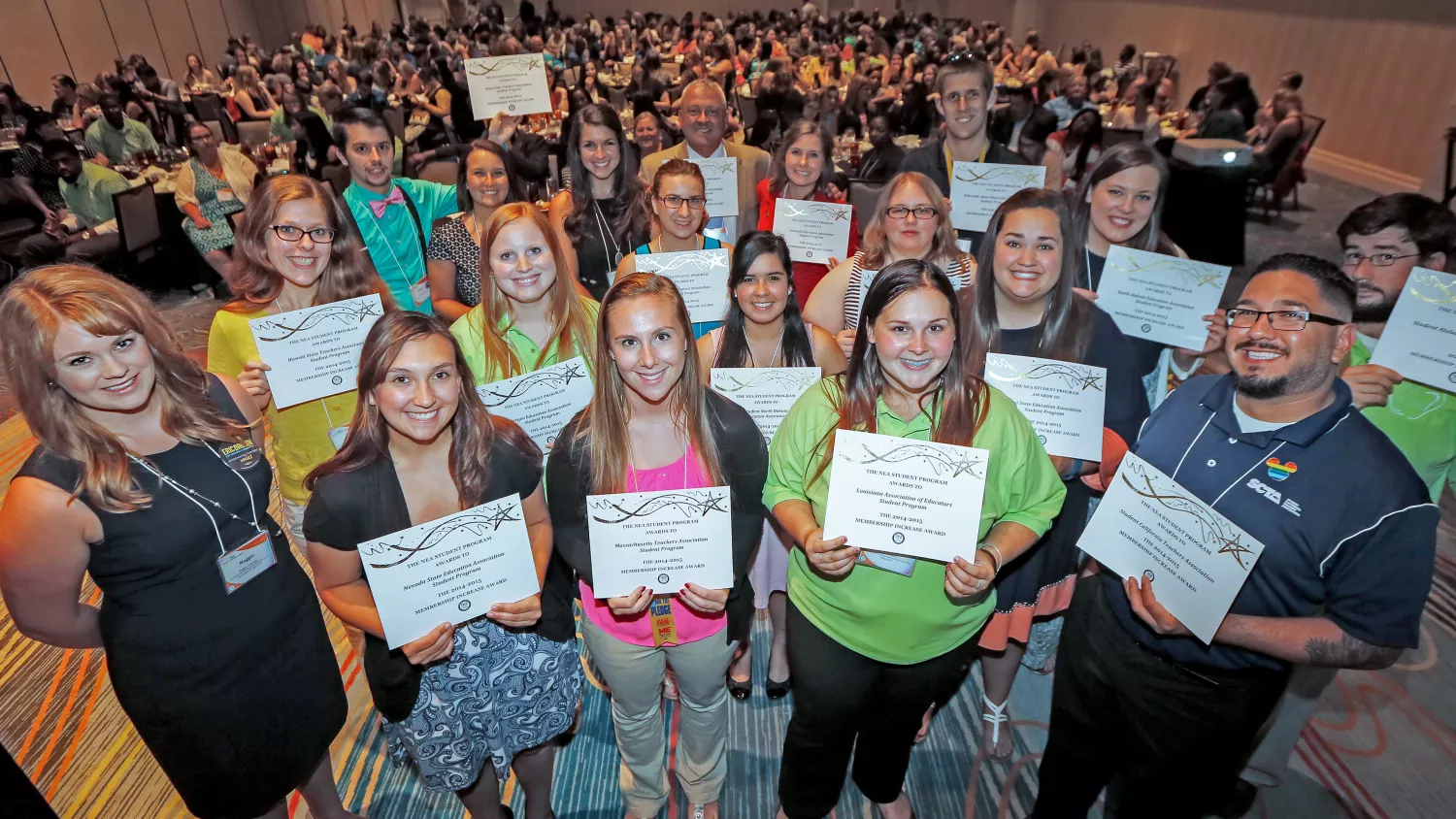
Select a Meeting Time
- When should your chapter meet?
Your chapter should consider how many meetings to hold each semester. Make sure to consider midterms, finals, and breaks. For a meeting time, consider schedule patterns for all education major programs, night classes, and required classes to avoid time conflicts. Consider holding virtual meetings to allow for greater participation.
Determine a Meeting Location
- Where is the most accessible place for meetings?
When selecting a meeting location, consider the location of your education building (if you have one), how many members you are expecting, and if your university has any restrictions or requirements for meeting locations. Make sure to reserve your meeting location before the start of the semester. If you have a student organization center on campus, see which available locations you are allowed to reserve for meetings.
Notes About Meeting Time and Location
- Consistency is important!
Keep meeting times and locations consistent throughout the semester. If meetings must be cancelled or changed, give members at least 24-48 hours of advance notice, when possible.
Plan Chapter Goals
- Start thinking about what your short-term and long-term goals are for the year.
What events (beyond chapter meetings) are you planning? What partnerships do you seek to build? How do you plan to recruit and retain members throughout the year? This is a time for chapter leaders, your advisor, state affiliate, and new members to have a voice in your chapter’s plans for the year.
Event Ideas
NEA Aspiring Educators Core Values
Make sure to involve the four core values of Aspiring Educators into your meeting planning:
- Educator Quality
- Community Engagement
- Political Action
- Social Justice
Check out more details about the core values in Chapter One, but here are a few examples of events related to our four core values:
SOCIAL JUSTICE
- Education issues tabling event
- Town hall panel on public education
- Awareness days: #RedforEd
- Social media campaigns for education issues
- Social justice movie nights/book clubs
- Support local organizations fighting for racial justice, LGBTQ+ issues, climate justice
COMMUNITY ENGAGEMENT
- Toy/book/food/school supply drive
- Volunteer at local non-profits
- Build partnership with a local school to help
- Collaborate with local education association on their community projects
- Work with other community/campus organizations on mutually beneficial projects
POLITICAL ACTION
- Lobby night
- Voter registration drives
- Presidential debate watch parties
- Invitations to locally elected leaders
EDUCATOR QUALITY
- Professional development
- Micro-credentials
- Job preparation: resume, interview, job search help
Here are some other examples of event topics that address multiple core values:
TECHNOLOGY
- Audio/visual aids
- Computer use
- Social media
- Stay safe and private online
- Teaching students about best online practices
- Remaining professional online
- Meaningful and attainable technology integration
- Digital media learning environments
- Following copyright regulations for virtual and in-person classes
EDUCATOR HEALTH
- Coping with stress
- Time management
- Money management
- Teacher burnout
- Secondary trauma
- Conflict resolution
- Voicing concerns to administrators
HIRING AND INTERVIEWS
- Mock interviews
- Resumé writing
- Portfolios
- Principal or administrator panel
- Contracts
- Important questions to ask your hiring team
PROGRAM SPECIFIC MEETINGS
- Application process to education program
- Discussion of required tests or classes for education students
- Promotion of university sponsored events
- Student teaching
- Certifications
UNION AND ASSOCIATION
- Explaining union membership
- Membership benefits
- Educational law
- Employee rights
- Local union leader panel
- Salary schedules
CLASSROOM MANAGEMENT
- Discipline: restorative justice, meaningful consequences
- Student motivation
- Study skills
- First day of school
- Classroom culture
- Social justice and inclusion
- Drug awareness
COMMUNICATION
- Parent-teacher communication
- Student-teacher communication
- Conflict resolution with students, parents, and administrators
- Professional communication with colleagues
- Voicing concerns of teachers
CURRENT EVENTS
- Licensure changes
- Union activity
- News affecting teachers
- Education reform
- Community events that affect students
- GOTV
- Day at the Capitol/Lobby Day
FIRST-YEAR TEACHER TIPS
- Involvement in the community
- Classroom set-up
- Money management
- Standards and requirements
- Consistent self-care
- Lesson planning
- Student teacher panel
- Brain-based culturally responsive practices
- Planning for classroom management
- Positive home/family connections
PROFESSIONAL DEVELOPMENT
- ALICE/active shooter training
- Diversity training stereotyping/bias
- Grant writing
- Testing
- Subject integration
- Business community integration
- Children at risk
- First aid/CPR training
Contacting Guest Speakers
Requesting guest speakers lends credibility to your organization, can increase membership, and provides your members with more resources for their future classrooms.
Types of Speakers to Invite
Who Should You Ask?
- Local association leaders and staff
- State association leaders and staff
- National association leaders and staff
- Local educators
- Local administrators
- Local principals
- Education support professionals
- Volunteer organizations
- School board members
- Faculty from your school of education
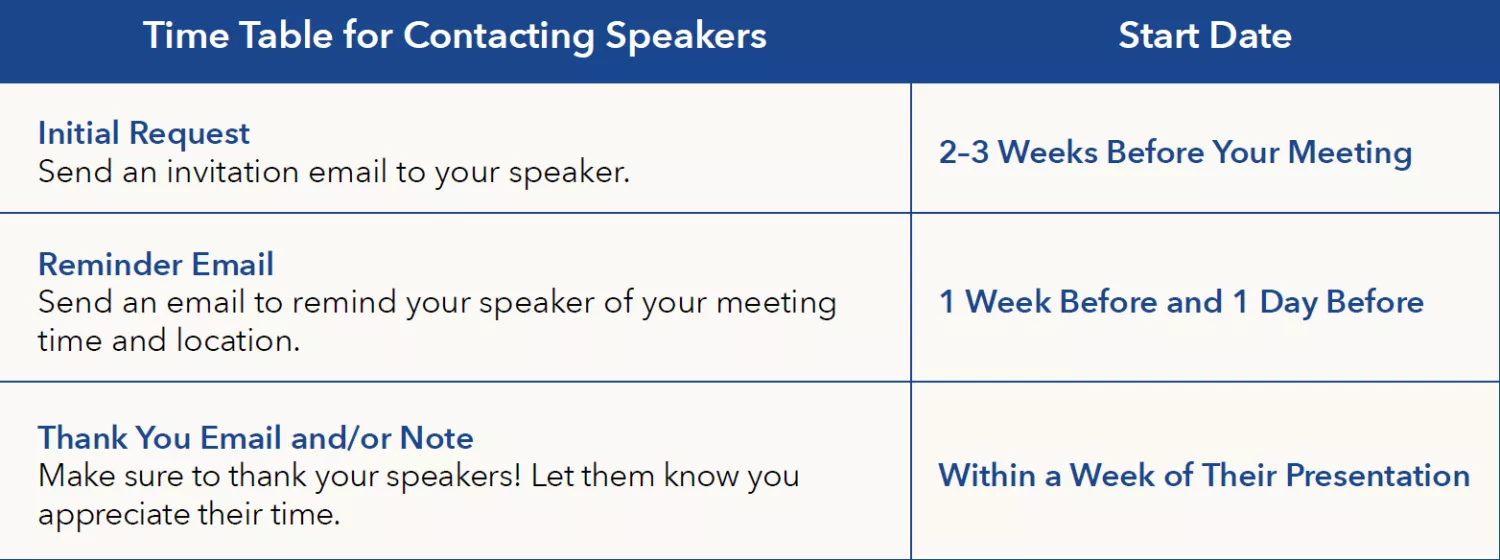
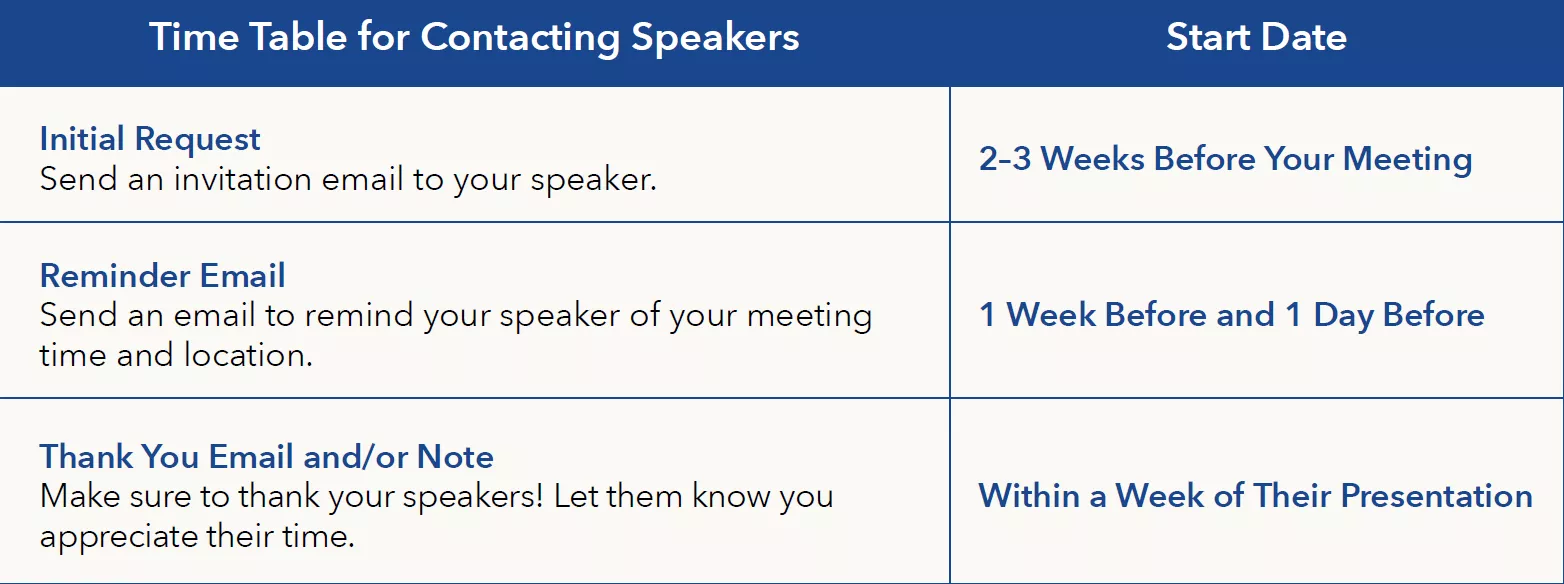
Speaker Request Templates
Initial Request
Good morning,
This is __________, (Position X) with Aspiring Educators at University__________. Our organization works to best prepare pre-service educators with professional and leadership development opportunities. We would like to invite you to speak at our meeting (on this day about this topic). Our meetings take place (in X building at this time).
Please let us know if you are interested in and available to speak at our meeting. Also, let us know if you have any questions.
We are looking forward to hearing back from you!
Thank you,
Your Name
Reminder Email
Good morning,
This is __________, (Position X) with Aspiring Educators at University__________. Thank you for agreeing to speak at the Aspiring Educators meeting tomorrow! We are looking forward to your presentation on (X topic). Just a reminder that our meeting is (at this time in this room). Please let us know if there is anything you need.
Let us know if you have any questions! Looking forward to seeing you (on the day of meeting)
Thank you,
Your Name
Thank You Email or Thank You Note
Good morning,
Thank you so much for presenting at our meeting. Our members appreciated your insight on (this topic). We appreciate you taking time out of your busy schedule to help us better prepare ourselves for our future careers. Have a great day!
Sincerely,
Your Name
Leadership Planning and Development
Leadership Planning and Development
Leadership Development
“Great leaders do not create followers, they create more leaders.” – Tom Peters
Leadership Styles
Everyone has their own style of leadership, and you will discover yours as you pursue your leadership role. But here are some things to think about:
Distributive Leadership
A leadership philosophy around growing leadership capacity to allow others to fulfill leadership roles. Essentially, it says, “You do NOT have to do it alone!” Leaders are not only the members who have titles. Every member is a leader in this association and in their classroom. To practice distributed leadership, one must empower other members to step up to the plate and take responsibility for tasks and initiatives. Regardless of their skill level, everyone has a place at the table and is able to serve the greater purpose of your chapter.
- With distributive leadership, you can allow others to lead their own groups, or committees, that are aimed at a specific goal.
- There are three main ideals encompassing distributive leadership:
- Autonomy – Allowing members to obtain ownership of their work and empower leaders by not being micromanaged.
- Accountability – The members that are leading these groups must be accountable and hold to the same standards as leaders.
- Capacity – Members must have the tools so succeed in their engagements.
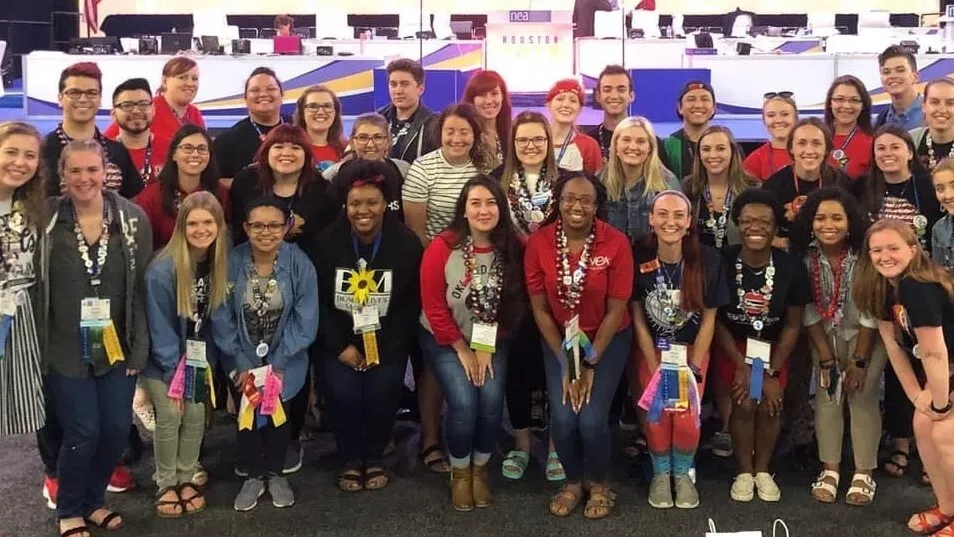
Servant Leadership
A leadership philosophy in which the main goal of the leader is to serve.
- This is different from traditional leadership where the leader’s focus is the thriving of their company or organizations. A servant leader shares power, puts the needs of their members first, and helps them develop and perform as highly as possible.
- As a leader, you need to make sure you account for the wants and needs of your members. A successful chapter is one that creates opportunities that members are intrinsically passionate and excited about getting involved with.
Roles of Chapter Leadership
Within your chapter, there are a few roles that are typically assumed. These may vary from chapter to chapter, and you may fill them as you see fit. All chapters, have varying roles, from Community Outreach Liaison to Past Officer to Fun Chair, remember to make your chapter yours:
President
- Provide leadership to the chapter by being informed on the local, state, and national student programs.
- Preside at all chapter meetings. Plan and organize each meeting with a purpose.
- Work with the chapter advisor to seek advice and help promote an effective chapter.
- Record activities and report them to state organizers.
Vice President
- Assist President when requested.
- Assume official duties unless someone is assigned to do so.
- Be involved with membership developments.
Secretary
- Keep meeting minutes that can be distributed to officers, advisors, and members when necessary.
- Work closely with the chapter advisor.
- Keep the chapter informed on events and development opportunities.
Treasurer
- Keep an accurate and up-to-date record of all funds for the chapter.
- See that membership forms are available when needed.
- Give receipts for all money collected and deposit all chapter funds.
- Work with other officers to create an annual budget.
Shadowing/President-Elect Structure
- When bringing up the next layer of leaders, it is important for them to know what responsibilities for which they are accountable. To assure your next leaders are aware of these and prepared, have them shadow officers that they are going to be replacing before they transition into the role.
- One opportunity of doing this is having some roles have their own committees. For example, the Secretary may have a Communications Committee that helps break down the responsibilities of the role and allow others to gain more experience before leading the committee.
- Another avenue for this is to elect a President-Elect. The President Elect is to be chosen at the same time at elections and will serve as the President during the following term. During their time as President-Elect, they will shadow the President and assist with the chapter board to learn how the chapter runs. Some chapters will also integrate this role as the Vice-President position.
It is important to know your regional, state, and national leaders, as well. Reach out to your state Aspiring Educators Program to get more information on contact information for other Aspiring Educators leaders and various leadership structures.
Setting Goals
Set Realistic Goals
Be mindful of how you approach your work and goal setting. While goals can help guide your journey towards member engagement success, lofty and unattainable goals can lead to burnout, dissatisfaction, and decrease in member engagement. A goal gives a clear understanding of ideas and responsibilities for group members. Essentially, it gives purpose and direction to the movement of your members. following this simple process at one of your first meetings:
- BRAINSTORM: Gather together and record all ideas. Some chapters use chart paper and sticky notes in meetings so that all participants are able to contribute their ideas. Remember, you are trying to include everyone, so be sure that each person has a voice (i.e., sticky note). During this step, remember not to evaluate or criticize ideas. The goal of brainstorming to cultivate members contributing as many ideas as possible.
- NARROW FOCUS: Openly discuss the ideas shared during the brainstorming phase. After, begin to collaboratively narrow the list to a more manageable and practical list. Perhaps you group each idea by the Aspiring Educators core values (i.e., Educator Quality, Political Action, Social Justice, Community Engagement) or priority.
- IDENTIFY GOALS: Select two to three focuses for the current academic year. Then, write goal statements that lend to your group reaching the selected focus. They should be stated broadly at first and then narrow down to the details. Take a look at the SMART acronym below for guidance on writing effective goals.
- Fundraising … Add $200 to our treasury by the end of the semester to implement (project X).
- Sponsor speakers … We will sponsor educational guest speakers during the year who will address topics relevant to our core values.
- SET OBJECTIVES: Objectives are smaller steps necessary to achieve your goals. Essentially, objectives detail how you will reach a goal. To set objectives, follow the same guidelines for starting goals.
- By the end of the semester, we will add $200 to our treasury … We will raise money by holding two bake sales.
- We will sponsor educational guest speakers during the year … Our group will host two speakers each semester.
- ESTABLISH A TIMELINE: Frame your ideas in the context of other goals—and your obligations as students—or they might fall by the wayside. Collaboratively pencil in dates on a calendar and discuss this with members. Once a calendar is confirmed, distribute a copy of it to each member.
- FOLLOW THROUGH: Refer to your goals every time you meet to make sure you are remaining focused. If adjustments need to be made, feel free.
- INVOLVEMENT: Involve as many members as possible in the process from brainstorming to when goals are actually accomplished. Involvement leads to commitment.
SMART Goals
The SMART acronym is a guide to help you and your members establish realistic goals. Using the acronym in the goal setting process will help your chapter further clarify ideas, focus efforts, use time (and other resources) effectively, and achieve what your chapter wants. The acronym is depicted below. Two examples of SMART goal setting templates are included in this toolkit.
S – Specific
M – Measurable
A – Attainable
R – Relevant
T – Timing and time frame
(is the time right and when will it be accomplished?)
- SMART Goal Template
- Membership vs. Engagement: What do you think is better? A large chapter with 100 members on its roster or a smaller chapter with 20 members who attend meetings, participate in the chapters initiatives, and share the value of membership with other Aspiring Educators? More importantly, which chapter do you think will have more impact on its campus and steer members toward continued participation in our association?
Often, students at various institutions are required to show proof of portability insurance to engage in observation or student teaching. In efforts to meet these requirements, students will join professional associations such as the National Education Association or other teacher associations to reap the sole benefit of insurance. When this and like instances occur, we gain members who may not understand the full benefit of joining our association (e.g., additional benefits, professional development, community/ network of educators, loan forgiveness). Additional members are good. However, all chapters must ensure that these new members are engaged. Engagement can look different from chapter to chapter, and person to person. However, it must start with communication. Consider how you communicate with potential and new members about everything the Association and your chapter has to offer. Think innovatively about including the passions and talents of others in your chapter work. There is a place for everyone in this association, but we must invite them in.
Download the Executive Team Goal Setting Form
Download the SMART Goals Template
Self-Care for Leaders
Self-care represents activities we intentionally engage in to take care of our mental, emotional, and physical health. It appears simple, however, it is easy to overlook. Good self-care is key to improved mood and reduced anxiety. Engaging in self-care can promote our wellbeing and increase the quality of work you produce for your chapter. It’s also key to a good relationship with oneself and others.
Self-care is NOT selfish. In fact, it is a useful strategy to ensure you stay refueled, and ready to work. How effective are you as a leader if you are sick or can not get along well with others? Additionally, your members will follow in your footsteps. Twenty-first century leaders must practice self-care if they truly believe their members should be doing the same.
Below are a few strategies you can use to ensure you are your best as a leader:
- Make self-care your “normal”
- Get enough sleep
- Eat healthy foods
- Exercise frequently
- Be able to say “yes” and “no” to others
- Plan an exciting trip or activity
- Spend time outside
- Plan ahead
- Stay organized
- Read a book
- Schedule time for yourself
Make sure you as a leader are surrounding yourself with other leaders who don’t just practice their own self-care, but also encourage you to practice your own in your own way. Your support group of friends, advisors, and even members must be there to support you in your development of mental, emotional, and physical health.
Chapter Meetings
Chapter Meetings
Before Chapter Meetings
Meeting Preparation
Leadership Team Preparation
- Create visual aid to guide the meeting agenda
- Create a sign-in format for members
- Assign roles for the team (speakers, greeters, note takers, etc.)
- Arrange for team and other meeting attendees to take the lead on parts of the agenda
- If applicable, designate a point person to greet a guest speaker
Prepare Meeting Atmosphere
- Create a fun playlist for the start of the meeting
- If wanted, decide on snack ideas for the meeting
- Prepare fun, easy icebreakers for members
- Assign greeters to welcome all members
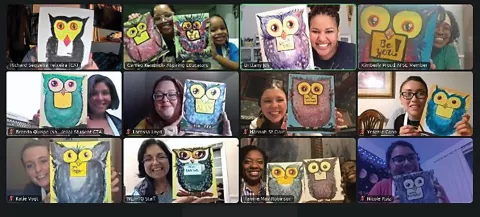
Member Incentives
- Decide on any incentives or giveaways for members
- Prepare leadership or volunteer opportunities for engaged members
- If you need giveaways, contact your state affiliate to see what is available
Things to Keep In Mind
- Designate a time for the leadership team to arrive
- Assign one team member to create a sign-in system for members
- Remind one (or more) team member(s) to bring snacks (if applicable)
Member Experience + Community Building
- Set up slide deck or visual aid to guide the meeting
- Be sure to test all links, video clips, etc., in the slide deck to make sure they work
- Make sure to have an activity or something t do as people are coming in—even signing up for events or following social media counts!
- Turn on upbeat, fun playlist
- Set up any membership incentives like raffles or give-aways
Advertisement and Communication
Two Weeks Before Meeting
Announce date, any guest speakers or chapter activities.
- Social Media
- GroupMe
One Week Before Meeting
Remind time and location, any guest speakers or chapter activities.
- Social Media
- GroupMe
- Remind 101
Day of Meeting
Remind location, let people know what to bring, and any incentives that will be at the meeting.
- Social Media
- GroupMe
Sample Meeting Communication Plan
One Week Before Your Meeting/Event:
- Post the flyer on social media.
- Invite through your college’s email and your organization’s email.
- Your Education Department should be able to give you email addresses of the education students in the department. Inform them and invite them to the meeting.
- Do an email blast sending the meeting flyer and say “Come for a chance to win a prize!”

Four days Before the Meeting /Event:
- Chalkify: Write your flyer advertisements in Chalk on the sidewalk. Take a picture of your advertisement. Ask people to find the advertisement on campus and you will repost their post. On social media, people enjoy being reposted and being thanked for being reposted.
Three days Before the Meeting/Event:
- Post a QR code on campus to promote your event.
Here is a great website: www.qr-code-generator.com - Print out flyers and give them out to people on campus near high traffic areas like dorm rooms, eating areas, campus events and etc.
- Talk to people.
One day Before the Meeting/Event:
- Post your flyer on social media.
Meeting Tips
Stay Organized
- Follow an agenda and share it with others in the meeting.
- Provide introductions of leaders in the organization.
- Explain the levels of unionism: Local, State, and National.
- Provide examples of involvement.
Always Keep Members in Mind
- Meetings should be between 20 minutes to one hour; be sure to respect members’ times and their other priorities.
- Provide opportunities for questions and interactive feedback.
- Allow for questions to be asked anonymously with tools like Polleverywhere.
- Offer to answer questions after the meeting in one-on-one settings.
- Provide some follow-up so members DO something with the content of the meting in the days/weeks that follow.
Sample Meeting Agenda
Meeting Title
Meeting Date, Time, Location
Meeting Objectives:
By the end of the meeting, members will...
Agenda:
Welcome and Introductions-Leader
Leadership Team, Chapter Advisor, Special Guests, First-Timers
Ice Breaker/Community Builder-Leader
Chapter/Union Introduction-Leader
Quickly, each meeting should include some type of introduction to the union and your chapter for all new and returning members. You could extend this opportunity to non-leadership team members of your organization, too.
Guest Speakers Announcements-Leader
If you have special guests who have come for a quick announcement, let them share first.
Chapter Updates-Leader
If you have upcoming events, leadership opportunities, updates from the state or national organization, announce them in the beginning for people to hear and have time to think about or ask questions.
If you don’t have anything upcoming, now is a time to ask open-ended questions and start the dialogue with members about what your chapter’s goals are for the year and what you want to start planning.
Presentations/Professional Development/Chapter Activity-Leader
If you have an activity, presentation, or professional development session, start after your chapter announcements have been shared. Keep in mind some people will leave early or come late, so make sure to have an officer in the back of the room during this session.
Chapter Incentives-Leader
Chapter raffles, membership points, giveaways, or free membership announcements go here.
Call to Action-Leader
Before members leave, what do they need to do? Sign up for the next event, follow on social media, bring a friend to the next meeting, etc.
Leadership Team Responsibilities:
List each leader here and what they’re responsible for. This will allow for more ownership of the meeting and provide an easy spot for all leaders to know how to prepare for the upcoming meeting.
Meeting Materials:
List all necessary materials here and who is responsible for them.
Creating a Meeting Slideshow—What to Include
Meeting Title
As you come in …
List some things members should do as they come in, like grab some food, complete the sign-in sheet, sign up for events, follow on social media, get to know a new member, etc.
Overview of Meeting Agenda
- Briefly review the agenda and ask members if there is anything they think need to be added. That way, you can plan for additional items at the end.
- Let members know what time the meeting will conclude.
Ice Breaker/Community Builder
- Provide any directions here, or add a cool picture or graphic.
Chapter/Union Introduction
- Do a quick overview of what your chapter stands for, what your plans are for the year, why you’re a member, etc.
- Include your core values, the membership umbrella, or other images here.
Chapter Updates
- Events, leadership opportunities, state/national opportunities and how to sign up.
- Providing a bit.ly/tinyurl link or QR code on this slide is very helpful.
Presentations/PD/Chapter Activity
- Introduce your guest with a quick biography and picture here, provide instructions for the meeting activity, or enter in slides about a specific topic you want to discuss here.
Wrap Up/Ending Announcements
- List everything the members should do before they leave the meeting.
- Thank them for coming.
- Make sure to include your preferred communication tool here and how to find it (social media, text platform, email listserv, etc.).
Ice Breaker
Ball Toss
Use a light ball to toss among members, and
have them introduce themselves.
- Use variations to incorporate small groups, different questions, remembering previous names, time competitions.
People Bingo
Design a bingo sheet (or have everyone use their own paper) to encourage members to meet new people.
- Use variations to have members gain social media/phone numbers from other members.
Secret Identity
Ask members to write down famous people on sticky notes, then have everyone go around asking yes/no questions to try to figure out who they are.
- Use variations to incorporate executive board members, adjectives, verbs, college professors.
Skittles
Give each member a handful of Skittles and have them answer random questions for each different color.
- Use variations by saying number of people for each color is dependent on number of colored Skittles received or number of answers to give based on number of colored Skittles received.
Pick a Side
Ask members questions and have them go to different sides of room depending on answer, then have them discuss answers with 2 people.
- Use variations to discuss education-related issues, holiday favorites.
Speed Dating
Randomly pair up members and have them discuss common interests for 30 seconds each, then switch.
- Use variations to discuss education-related issues, favorite classes.
Minute Mysteries
Split members up into groups of 3-5, and give each group a mystery to solve
- Use variations to discuss future classroom strategies and concerns.
Paper Plate Artist
Each member gets a marker and paper plate to hold on top of their head. Tell them to start drawing an image (ex: teacher writing on chalkboard—draw the ground, draw a chalkboard, draw a teacher, draw a clock on wall) and at the end, give points for each correct aspect (teacher on ground, teacher actually holding chalk).
- Use variations to draw different images.
Chaos
Use 3-4 light balls to toss among members, each member must say “thanks (previous name), my name is (__________________), hey (next name),” start timing and introduce more balls as they get faster.
- Use variations to insert hobbies/interests/ majors after name.
After Meetings
Post-Meeting Communication
- Send out a follow-up communication with members:
- Thank them for coming
- Provide a brief recap of the meeting, and highlight any sign-ups/opportunities
- Remind them of the next meeting time and location
- Send thank you emails or notes to speakers (if applicable)
- Post information about your event on social media and promote future events
Team Debrief
- Discuss impressions of the meeting
- Brainstorm improvements for the next meeting
- Assign tasks for the next meeting
Communication
Communication
Making Your Chapter Known
As an Aspiring Educator, more than likely you are at an institution that has an academic program that is housed under an academic department for similar majors/programs. Even if not, you may not be the only student interested in a career in education. In efforts to ensure that your college’s dean, administrator, faculty, and staff are aware of your group’s presence, it is best to reach out to the Office of the Dean and arrange a time to discuss your group’s establishment and goals. Furthermore, approaching the conversation with curiosity and willingness to collaborate with your college’s current goals and aims could increase support from your college. Perhaps there is a college calendar or email system you utilize to get the word out about your chapter and events.

Another popular way to recruit new members is to arrange time with faculty to speak to their classes about your organization. We call these “class raps.” During this time, you could briefly share information related to member benefits and upcoming events. Faculty may also be interested in partnering to host specific events; be willing and open to discuss potential collaborations. Perhaps, they will incentivise their students with “extra credit” or “participation” for attending your
events. See “Class Rap Best Practices” for more information.
At time you share information about your organization during your recruitment activities, be sure to share your “why.” People want to understand and connect to your motivation. Sharing your values and experiences make you relatable.
Below are additional ways that you can make a presence on your campus:
- Orientation and Tabling: Attend events such as new student orientation and major-specific orientations to make a good first impression with newer students. Tabling at these events and in high trafficked areas of your campus could yield new members. Remember nontraditional students, too, like your international student office, transfer students, or day cares on campus.
- Giveaways: Offer incentives for prospective and new members to attend events and meetings. Everyone loves gifts and food.
- Consistent Presence: On your chapter’s calendar, Include specific dates and events where you would like to table on campus. Being consistent and strategic in selecting days to be present on campus could make a huge statement.
- Know Your Student Body: Every campus is different as various types of students may attend a particular institution. You and your chapter should consider your audience, or what type of students attend your institution. Below a few examples of types of students:
- First-Year Student: Students who are attending a post-secondary institution like yours for the very first time. They are new to the institution, its culture, and offerings. Their needs may include: support navigating new systems/policies, understanding how things work, and a sense of inclusion/support.
- Transfer Student: Students who are transferring to your institution after attending another one. These students typically come with credit hours and experience being on a college campus. Their needs may include: support navigating new systems/policies, understanding how things work on your campus, and a sense of inclusion/support.
- Non-traditional Student: Students who are attending your institution, but do not meet the norms of college students (e.g., older/ younger students, employed students, students who live off campus, students who have children, students enrolled in online programs, English language learners, etc.). Their needs may vary depending on what makes them unique. Your chapter would benefit greatly from asking them what their needs are, and how they want to be supported.
- Student Teachers: Students who are typically toward the end of their academic plan of study and may spend time in a K-12 school setting. Their needs may include: sense of community/support, mentorship, practical strategies for navigating schools/classrooms, job search preparation, assistance understanding how to transition from a student member to an active member.
Class Rap Best Practices
Class raps are a great way to recruit members because you can reach a large targeted and captive audience multiple times. You may want to target which classes you speak to by considering which professors you know, which classes have the most people in them or by which classes are most relevant to education.
- Class raps are short 2 minute speeches given before or after class. They are an excellent tool to not only get you and your members comfortable with speaking about NEA Aspiring Educators, but they are also one of the best ways to recruit, educate and gather aspiring educator support for your organization as well as individual events.
- Be prepared! Bring event flyers, sign-in sheets, membership forms, or fun recruitment giveaways!
- Work with your campus advisor on reaching out to professors.
- Email or meet with professors in advance to ask them if you can take 2 minutes of class time to tell students about the Aspiring Educators Program.
- Practice in chapter meetings, at home, or with a friend to make sure you get your talk down to just around 2 minutes.
SAMPLE:
Hi! My name is ___ and I’m here to talk to you about NEA Aspiring Educators. We are a group of 50,000 college students preparing to be educators who are committed to supporting, developing, and empowering diverse aspiring educators to ensure students have high-quality educators, leaders, and advocates in every public school. We are committed to our four core values that will elevate the education profession: Educator Quality, Community Engagement, Political Action, and Social Justice. On campus, we ___ (insert some of your best events, activities, or planned programs).
This is where you want to give them the “ask”:
- You will ask them to become a member. If they are not ready to become a member, give them a way to contact you, or ask for their contact information. Have a contact sheet or contact cards for them to fill out.
- If you ask them to come to an event or call a legislator, you should pass out a flyer or a reminder with the appropriate information.
Thanks for your time! We hope you are able to join our union family and professional network. Thank you Professor ______ for giving me the opportunity to speak with all of you. Hope to see you soon!
Digital Engagement
Ideas for Posting on Social Media:
Follow other Aspiring Educators social media accounts to see what other groups are doing, and provide solidarity and support:
- NEA Aspiring Educators – Facebook
- neaaspiringed – Instagram
- Go Live … during meetings so online students or those who can’t attend can see what’s happening
- Make announcements about events or other subjects
- Stream or live Tweet speeches from influential speakers
Facebook Specific Features:
- Use the “Events” feature to create events for weekly meetings and other activities that your chapter or state is putting on
- Use Facebook Stories to interact with members:
- Use polls to create a question that members can respond to with the option of two answers
Instagram Specific Features:
- Use Instagram Stories to:
- Ask a question with a two-answer option
- Ask me a question
- This feature allows anyone to send you a question
- Great for interacting with members and seeing what information they would like
- Post a countdown to an event or deadline to turn in a form
- View the NEA AE Instagram Stories for inspiration on how to use the story feature to keep information like a website
Post Information About:
- Chapters:
- Chapter meeting schedule
- Statewide or national Zoom call schedule
- Information on chapter events
- Information on upcoming conferences
- State Program:
- Statewide or national Zoom call schedule
- Re-post from chapters in the state so that members can see what other chapters are doing
- Information on state events, like conferences
- Information on what the leadership team is doing to represent the program
- All Levels:
- Membership Monday – feature a short blurb and picture of general members
- At the beginning of the year, introduce your leadership team through postings (either group picture or a Membership Monday feature with a short blurb and a picture for each leader on the team)
- Education policy information
- Resources that could be used in future classrooms
- Social and racial justice resources
- Postings can convey information from chapters, the state program or the national program
Newsletters:
Great way to send out information regularly to members
- Information could include (but not limited to)
- Upcoming conference opportunities
- Upcoming events
- Reflection and pictures from a recent event or conference
- Sharing resources
- Reports
- Some groups use sites like MailChimp to send emails to many people at one time
How to Create Social Media Post Flyers:
- Programs like …
- Canva https://www.canva.com
- Adobe Express express.adobe.com
- Links can be helpful to provide in posts (like for a conference registration sign-up)
- QR Codes –
- A way to include a link
- You can look up several free QR code generators online that are easy to use!
Financial Information
Financial Information
Dues:
- Each NEA state affiliate is different in how membership dues are collected, but typically there are three levels of dues that a person pays depending on their career level:
- National level
- State level
- College/University level
- Chapter dues are important because they are what help bring in money to fund activities.
- Paying dues allows students to become members of the Aspiring Educators Program.
- Students usually do not have to pay for socials, banquets, or activities if they have paid their membership dues for their Aspiring Educators Program at their college/university.
- You can determine what you think your dues should be by talking to your board and your chapter.
- What do members get for paying dues?
- Membership to the Aspiring Educators Program
- Access to professional development opportunities
- $1 million insurance coverage in liability and legal fees (good for student teaching, or practicum)
- Discounts for a lot of places (restaurants, travel, amusement parks etc.)
Creating a Budget:
- It is important to have a budget because you want to keep track of what your chapter is spending and what you are going to use your money for.
- It should reflect your chapter goals and plans for the year.
- How will you generate chapter funds?
- member dues
- fundraisers
- grants
- student government association on
- campus, etc.

When developing your chapter budget, you should:
- Calculate how much money you think you will need for various activities and meetings. For example, how much will you need for: Read Across America Day, leadership conferences, state Aspiring Ed conferences, national Aspiring Ed conference, monthly campus meetings, socials, etc.
- Reach out to other chapters in the state to get estimates of what they spend on events to help in your budgeting. Divide your budget by semester if possible, to make it easier for your board.
- Make sure that your treasurer goes to the training/meetings that they are supposed to go to on campus.
Fundraiser Ideas:
- Doublegood Fundraiser: Is a gourmet popcorn fundraiser where you get back 50 percent of the profit that you make. Chapters can make it a fun competition by seeing who can raise the most money. www.doublegood.com
- Thirty-One Bags: Thirty-One makes great teacher bags and graduation gifts. You have to find a consultant close to your campus or one that is willing to come to your campus to show off some of the items that they sell. www.mythirtyone.com
- Bake sale: Members can make a variety of goods to sell at a table on campus. Make sure to get approval from the student government on campus. Additionally, it’s helpful to make some gluten-free options, and have the ingredients list available at the bake sale.
- Tee Springs T-shirt sales: You can design your state shirts with your different logos and then sell them online for a certain price, then you will get a percentage back. You can sell them at meetings, conferences, or have a campaign online. You can also sell cups, mugs, stickers. teespring.com
- Reach out to local restaurants. They give you a percentage of money earned if customers mention your organization on a set day.
Fundraiser Nights:
- Welcome Back Table or Party: When you return from a major break, such as winter break, the first 2 weeks of school is a great time to talk to new students.
- Mentoring Program: Big & Little: For individuals, studies show that good mentoring can lead to greater chapter success. Organizations that embrace mentoring are rewarded with higher levels of member engagement, retention, and able to share more knowledge with the students in their chapter.
- Partnering: Match a senior AE member with a freshman based on similar interests.
- Door Prizes & Raffles: Everyone enjoys free things. If you set a member goal, you can reward new members who sign up.
Aspiring Educator Grants
Aspiring Educator Grants
CREATE Grants Linked to AE Core Values
“Through our core values we promote educator quality, community engagement, political action, and social justice. Aspiring Educators become activists at all levels of the organization—local, state, and national. NEA Aspiring Educators program provides opportunities to engage with community partnerships and foster leadership development.”

When are they available?
How do we submit?
NEA has a new web platform for submitting grants! You can access the application here.
There are THREE grant application dates each year: October 15, February 1, and June 15.
What are the topics for grants?
Eligible categories for grants (up to $2000 each) are aligned with core values of the Aspiring Educators Program:
- EDUCATOR QUALITY – Projects involving preparation for professional practice, strengthening educator preparation programs, and/or support for career preparation and advancement
- COMMUNITY ENGAGEMENT – Projects involving partnerships with P-12 schools, local organizations, and other community-based involvement
- POLITICAL ACTION – Projects involving advocacy for policies, legislation, and political issues with an impact on education
- SOCIAL JUSTICE – Projects involving social justice issues activism and/or that contribute to the development of aspiring educator knowledge, skills, and dispositions as culturally responsive educators
ALL GRANTS will be built on your specific objectives/desired outcomes. In addition, every grant must address two targets (one or more elements of both):
- Strengthen the AE Program: promote the AE Program, increase AE membership, increase early educators’ involvement in the Association, support Aspiring Education leadership development, advance AE Program core values
- Improve partnerships and educator preparation: enhance collaboration, build stronger connections with NEA locals, strengthen connections between AE chapters and educator preparation providers, increase outreach to communities, and/or benefit students, schools, and/or their communities.
Tips for success
- Detailed responses are required for all questions. Create complete answers using Microsoft Word, then paste the responses into the online form. (Don’t assume that a small answer space on the web form means a short answer will be complete.)
- Desired outcomes must be aligned with required targets. Make sure to highlight how your grant will be of particular value to your setting, advances the AE program, grows and supports membership, and improves the quality of educator preparation for our members.
- Contact NEA staff with questions and to get feedback. Count on them as a resource for your tremendous work.
What Happens After Submission and After the Grant Is Complete?
- Final decisions on each application will be announced no later than 45 days following the submission deadline.
- CREATE grantees will be provided with a feedback form to describe what happened, successes, learnings, etc. This is a crucial part of the grant process.
Additional Resources
Additional Resources
Chapter Resources: The following are resources that Aspiring Educators have used to develop their chapters.
Communication
- Remind: Remind is a beneficial program for mass communication. The work team suggests that chapters use Remind for quick and easy text communication to each member’s cell phone. Chapter leaders can send reminders before meetings, trainings, NEA webinars, and other Aspiring Educator events, and each member will receive an SMS text with the message from their organization.
- Band: Band is a social communication tool for organizations. While Band is efficient for distributing files, sharing calendars, and storing documents, it is difficult to connect and communicate with other members. The work team believes there are other resources that more adequately provide a communication venue.
- GroupMe: GroupMe has proven to be a valuable resource for national, state, and local communication. A very straightforward and simple group messaging app, users are able to send pictures, files, and polls to communicate with one another. This app does not require a phone number or any other personal information. Compared to SMS messaging, the committee strongly encourages chapters to use GroupMe for leadership team communication.
- MailChimp: This service provides chapters the software to create emails, build websites, and setup automations creating an effective database to communicate with members. Uniquely, this resource allows leaders to see insights on their messages including how many recipients clicked links, viewed messages, and responded to data.
Chapter Organization
- Google Drive: Google Drive remains one of the most used resources among chapters. Allowing leaders to store files, images, and links, there is unlimited storage and it’s capacity can be viewed from any device using only a Google login. It goes without saying that chapters could benefit greatly from a Google account and Drive.
- TeamUp: This program provides chapters and other teams a free, helpful, and organized calendar where members of a chapter can view upcoming events in a visually appealing calendar format. State affiliates are already using this program and the committee feels very positively about TeamUp for chapter’s organization and event communication needs.
Digital Design
- Canva: Canva is a free tool to design event announcements, professional development posters, and other necessary graphics. Chapters can use this resource to engage members with creative resources relevant to the chapter.
- Adobe Express: Adobe Express is a free design and videography tool. The platform allows users to create videos and presentations.
Social Media
- Facebook: Facebook provides an easy way to make pages, groups, and events and get your message across to those around you. However, being a social media platform, chapters must acknowledge that not all members have accounts to this resource. The committee concludes that this be used as a supplemental resource but never as the sole communication platform for chapters.
- Instagram: Instagram provides an opportunity to create a profile with images, highlights, a regularly updated 24 hour story reel, and links in the biography. Chapters can also upload IGTV videos, go live for chapter events and meetings, and have an interactive story to promote two-way communication with their members.
- Later: Save time by scheduling posts across Instagram, Twitter, Facebook, and Pinterest at the same time—and easily optimize the image and caption for each one.
Virtual Meeting
- Zoom: Zoom is a good platform to use for all virtual meetings and events. National and state leadership teams have utilized Zoom for regular meetings connecting members from all geographical locations. Zoom also has a “break out room” feature, which allows for more interaction and smaller group planning online. This is a very efficient method to keep members engaged when unable to meet in person.
- Cisco Webex: In addition to Webex Meetings, Webex offers Training and Webex Events. Training has break out rooms, Q&A function, and the trainer has full control over muting and unmuting participants. The Events platform can accommodate up to 3,000 people, but is very limited in terms of videos and interaction.
References
Downloads
Learn More
What's On Your Mind?




